An Effective Islanding Detection Method for Distributed Generation Integrated Power Systems Using Gabor Transform Technique and Artificial Intelligence Techniques
Abstract
Incorporating distributed generation (DG) technology into modern power systems heralds a multitude of technological, economic, and environmental advantages. These encompass enhanced reliability, reduction in power losses, heightened efficiency, low initial investment requirements, abundant availability, and a minimized environmental footprint. However, the rapid detection and disconnection of DG units during islanding events are paramount to circumvent safety hazards and potential equipment damage. Although passive techniques are predominantly utilized for islanding protection due to their minimal systemic interference, their susceptibility to substantial nondetection zones (NDZ) instigates a transition toward more innovative techniques. Addressing this crucial need, the study employs a novel amalgamation of signal processing methodologies and a suite of intelligent classifiers to augment the detection of islanding events in power systems. Concealed features from a variety of signals are extracted by the methodology and utilized as robust inputs to the intelligent classifiers. This empowers these classifiers to make a reliable distinction between islanding events and other types of disturbances. The breadth of the study is expanded to evaluate a range of sophisticated models including gradient boosting, decision tree–based models, and multilayer perceptrons (MLPs). These models are thoroughly tested on a radial distribution system integrated with two DG units and subjected to rigorous simulations and comparative analysis using the DIgSILENT Power Factory software. The findings underscore the efficacy of the proposed method, showcasing a significant improvement over conventional techniques in terms of efficiency and resilience. Above all, the methodology exhibits an exceptional ability to discriminate between islanding events and other system disturbances. Specifically, the islanding detection method demonstrated a detection time of less than one cycle (20 ms), ensuring rapid response. Moreover, the proposed algorithm demonstrated the capability to detect all ranges of power mismatch, including zero-power mismatch, thereby eliminating the NDZ. These results illuminate the benefits of integrating signal processing methodologies with intelligent classifiers, marking a significant stride forward in the realm of islanding event detection.
1. Introduction
To fulfill the requirements of electrical load demands, distributed energy resources assume a significant role in the distribution systems. In contemporary times, there has been a surge in the utilization of renewable energy resources in the distribution system. This trend is attributed to the need to meet the escalating demand for electricity and address the global predicament associated with conventional energy sources such as coal, oil, and natural gas. Within the power system, the integration of distributed generation (DG) units into the utility infrastructure brings about several beneficial alterations, such as reducing air pollution, improving reliability and better power quality, and decreasing of the power losses. Figures 1 and 2 in this study demonstrate a notable contrast between conventional distribution systems and those with multiple embedded configurations, wherein supplementary DG units are often installed in close proximity to the local load. The conventional techniques employed in energy generation and dissemination are undergoing a transformation, thereby presenting novel challenges in the preservation of grid stability. In addition to these favorable effects, various technical challenges emerge, including concerns related to islanding detection, false tripping, system safety, and system stability and reliability. The depiction in Figure 3 highlights a crucial challenge associated with the integrations, namely, the islanding event that can be intentionally or unintentionally. The problematic scenario arises in the form of unintentional islanding, which occurs due to external factors and actions beyond the control of the DG plant controller [1]. If the system operates in island mode, it is imperative for the active segment of the distribution system to promptly detect the disconnection from the primary grid. Swiftly removing fast DG is considered a vital necessity in accordance with globally enforced DG connection codes. This precautionary measure is implemented to prevent equipment malfunctions, address grid safety concerns, and mitigate potential hazards to personnel safety [2]. Consequently, in the event of an islanding occurrence, it becomes imperative to swiftly disconnect all DGs sources that find themselves in an islanded state. Therefore, the islanding detection methods are studied by researchers and typically categorized into two primary groups as illustrated in Figure 4, each serving as a fundamental strategy for effectively detecting such events within power systems. The first approach involves the remote technique, wherein measurements and monitoring are executed on the utility side of the system. In contrast, the second method employs the local technique, entailing measurements and monitoring on the DG side of the power system. These techniques collectively play a pivotal role in ensuring the rapid and accurate identification of islanding events, contributing to the overall stability and safety of power systems. Several essential aspects can be used to assess how well islanding detection approaches work. The nondetection zone (NDZ) is the most prevalent feature, while the Q factor determines the sensitivity of the detection algorithm. Due to the disparity in power supply and load, NDZ is regarded as the region where islanding cannot be identified. The islanding detection approach fails to detect the islanding during the required time interval if the mismatch of active and reactive power between the DG generating power and load consuming power is too small [3]. Mathematically, the NDZ is expressed as NDZ = k·Q, where k is a constant that depends on the specific characteristics of the algorithm and the system under consideration [3]. The present study endeavors to develop a straightforward methodology that can effectively evaluate the state of islanding by discriminating between systemic islanding and nonislanding conditions.
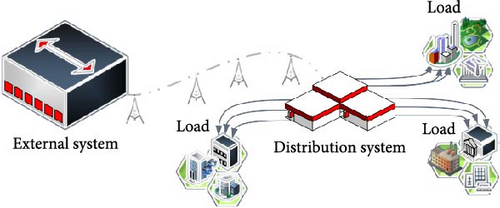
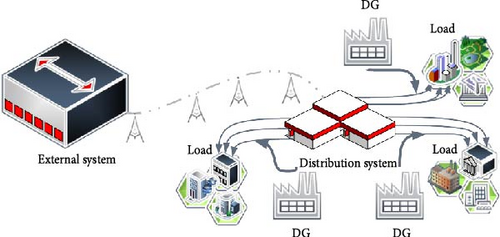
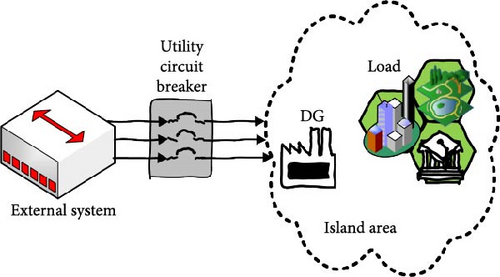
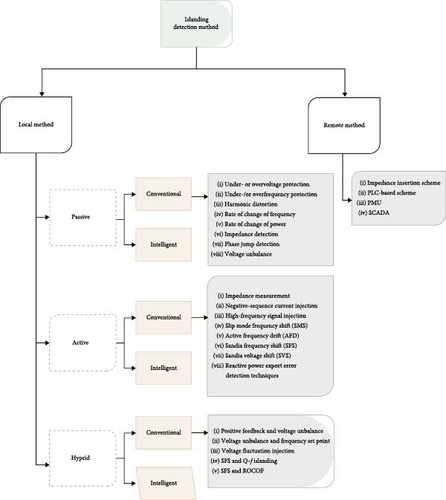
The proposed techniques encompass a diverse range of approaches; remote approaches rely on communication between DGs and utility circuit breakers via a central control unit and monitoring system. The central control unit obtains status signals from the circuit breakers through a communication channel that encompasses different channels such as fiber optic, private or leased digital networks, analog phone lines, digital phone lines, power line carriers, wireless radio, and two-wire transmission lines. Subsequently, the primary controller assesses the condition of the isolated power system and transmits the alert to the requisite distributed generators that constitute the island. These systems are considered resilient for islanding detection due to the absence of NDZ concerns. In [4], some remote approaches which briefly discussed the implementation of these strategies necessitate substantial financial investment, particularly at the infrastructural level. The main drawbacks of these remote techniques stem from their costly implementation, which is further compounded when employed in networks of limited scale. The local islanding detection approach pertains to the microgrid (MG) side. These methods are categorized into active, passive, or hybrid techniques which used to determine whether the grid voltage and frequency exceed the limits set by the applicable standard. Consequently, certain researchers are directing their focus toward the creation and execution of an islanding detection algorithm that employs a local approach. This approach necessitates the acquisition of measurements at the DG site, without the need for any communication infrastructure. The local method collects signal information, including voltage, frequency, harmonic distortion, and current, at the point of common coupling (PCC) between the DG site and the utility grid. In the island mode, the previous parameters exhibit significant variation contingent upon the power mismatch that exists between the system and the DG. According to recent research works, the passive islanding detection method is preferable even in cases in which the negative contribution of the active techniques can be considered negligible. The threshold values assigned to each of these variables distinguish islanding and grid-connected modes. The authors proposed an islanding detection method in reference [5], which utilizes voltage unbalance and total harmonic distortion of the current as two conventional variables. This approach enables the detection of islanding events without altering the DG loading variation. The study conducted by Zeineldin, El-Saadany, and Salama [6] delves into the impact of DG interface control on islanding detection and the assessment of the NDZ concerning overvoltage and undervoltage protection and overfrequency and underfrequency protection. This investigation employs a range of interface control techniques, such as constant current, constant active power–voltage (P-V), and constant active power–reactive power (P-Q) controls, to comprehensively evaluate their effects and outcomes. Conversely, in [7], the researchers conducted an investigation that involved a comparative and analytical examination of three passive anti-islanding techniques: undervoltage, under-/overfrequency, and the positive sequence impedance method. Among these approaches, the positive sequence impedance method demonstrated the swiftest response in detecting islanding events, as established by their findings.
In the context of islanding detection, the theories of instantaneous power and advanced power found application. As illustrated in [8], the technique under examination relied on the computation of instantaneous power at the PCC. This particular method exhibited notable success in the identification of islanding events within a constrained set of sampling intervals, as detailed in the referenced study. A technique was proposed in [9] that utilizes the instantaneous active and reactive power at the PCC of a MG. The MG in question comprises a natural gas–fired generator, a doubly-fed induction generator-type wind generator, a solar generator, and associated local loads. The power systems computer aided design (PSCAD)/electromagnetic transients including DC (EMTDC) simulator was utilized to evaluate the efficacy of the proposed technique in diverse scenarios, such as islanding conditions for multiple outputs of the MG and fault conditions that altered the fault’s position, type, inception angle, and resistance. The authors of [10] proposed a methodology that integrates the synchronous reference frame technique with conservative power theory. This approach has been employed to extract pertinent characteristics from three-phase electrical voltage signals under faulty conditions. The ultimate goal of this methodology is to detect and recognize islanding events. However, the major drawback of passive methods is the difficulty in distinguishing when load and generation are almost equal in an islanded distribution system. This situation may result in extensive NDZ. There have been numerous studies suggesting that traditional methods of islanding detection are being replaced by machine learning combined with signal processing methods. The integration of intelligent classifiers and signal processing techniques suggests the feasibility of achieving the objective of islanding detection. The prevalent intelligent classifiers utilized in islanding detection techniques based on signal processing include various decision trees (DT), adaptive neuro-fuzzy inference systems (ANFIS), random forests (RF), support vector machines (SVM), and fuzzy logic control. As a result, these methods are a sensible choice for islanding detection because of their ability to pick appropriate thresholds for detection as well as their ability to deal with complex conditions. Off-grid functioning may be estimated as fast as possible without any communication with utility components or concessions on power quality, which is the primary goal of these techniques. In addition to providing rapid estimation, the method offers excellent computational efficiency and good dependability and precision. For instance, in [11], the authors suggested an artificial neural network (ANN)-based technique for distributed synchronous generator islanding detection. In the study conducted by Kumar et al. [12], the investigation centered on the detection of islanding events in photovoltaic-based distributed power generation (PV-DPG). This approach hinged on the utilization of a variable Q-factor wavelet transform in combination with an ANN. Impressively, this methodology achieved an accuracy rate of 98% in categorizing PV-DPG states as either in an islanded condition or not, facilitated by the ANN classifier. Furthermore, the results underscored the robustness of this approach, demonstrating its effectiveness in environments characterized by varying levels of noise. Simultaneously, numerous other techniques, such as the Gray Wolf optimized artificial neural network (GWO-ANN), the probabilistic neural network (PNN), the extended neural network (ENN), the backpropagation neural network (BPNN), the self-organizing map (SOM), and the modular probabilistic neural network (MPNN), have been explored for islanding detection. In a parallel endeavor, authors in [13] introduced an intelligent islanding algorithm founded on multivariate analysis and data mining techniques. This innovative method generates DT that specify the thresholds, protection strategies, and tripping logic for each DG islanding relay deployed within the distribution network. The intelligent islanding relay (IIR) crafted using this approach consistently outperforms currently deployed islanding devices, offering higher levels of reliability and security while exhibiting a notably reduced NDZ. Additionally, a scholarly article cited as [14] proposed a method for detecting islanding events in hybrid systems, adding to the repertoire of islanding detection strategies.
- •
An innovative islanding detection method leveraging the Gabor transform (GT) in combination with an assortment of classifiers to differentiate between islanding and nonislanding events in power systems is proposed.
- •
The GT serves as a feature extraction tool, unraveling concealed characteristics from the instantaneous power for each phase and voltage signals at the target DG, which are then fed into the classifiers.
- •
The suite of classifiers, including the CatBoost intelligent classifier and others, is proposed to enhance the accuracy of the classification of islanding events.
The structure of the paper is as follows: Section 2 describes the tools and methods used for the proposed islanding detection method. Section 3 provides the procedure for the islanding detection employing the proposed algorithm, while Section 4 provides a description of the studied system. Finally, Section 5 provides the simulation results used to assess the algorithm’s performance.
2. Proposed Islanding Detection Algorithm
The challenge of detecting islanding is addressed as a multiclass classification problem in this study. Thus, this section elucidates the tools and methodologies employed for the proposed islanding detection algorithm. The suggested algorithm encompasses the computation of instantaneous power for each phase, the implementation of the GT technique, and the deployment of a selection of classifiers. Initially, the core principle of instantaneous power theory is explicated. Subsequently, the theory of the GT technique is detailed. Finally, a thorough discussion on the set of classifiers, including but not limited to the CatBoost classifier, is provided. These classifiers encompass gradient boosting models (CatBoost, XGBoost, and LightGBM), DT-based models (DT, RF, and ExtraTrees), and several architectures of MLP ANN, each contributing to the identification and classification of islanding events.
2.1. Instantaneous Power Theory
The expression pertains to the phase number denoted by k, the maximum voltage value represented by Vm, the maximum current value represented by Im, and the angular frequency represented by ω in units of rad/second. As evidenced by Equation (2), the instantaneous power per phase can be expressed as the sum of two distinct components: a constant term, denoted as (VmIm)/2, and a fluctuating term, represented by, . The proposed method utilizes instantaneous active power per phase.
2.2. GT
2.3. Implementation of Diverse Machine Learning Algorithms
2.3.1. Gradient Boosting Techniques
During each iteration, a new tree is fitted to the negative gradient of the loss function with respect to the predictions of the current ensemble. This has the effect of moving the model’s predictions along the gradient descent direction in the output space [22].
2.3.1.1. CatBoost Algorithm
The term “CatBoost” is a portmanteau of “categorical” and “boosting.” It is a machine learning technique that is based on the concept of gradient boosting, which has broad applications in various domains such as fraud detection, recommendation systems, and forecasting. CatBoost is a novel open-source machine learning algorithm that has been designed to effectively handle categorical features characterized by a discrete set of values, commonly referred to as categories, which are not necessarily comparable. As a result, these features cannot be directly utilized in binary DT [23].
The mathematical definition of a category involves the utilization of an input vector, while network classifiers are trained through the use of data that possesses a general classification. Several machine learning techniques employ rudimentary approaches like one-hot encoding. In a similar vein, CatBoost conducts one-hot encoding automatically to convert categorical data into numerical data. Another approach is target encoding (TE) by replacing the categorical value with the mean target value of the training data for that value of the categorical variable [24]. CatBoost also has the option to utilize ordinal encoding (OE) if the categorical feature has an ordinal nature [25]. This can be done by passing a list of the categorical feature names to the cat_features parameter when creating the model and then selecting one of the aforementioned methods according to the categorical feature type. In contrast to deep learning, CatBoost does not necessitate vast datasets for extensive training. CatBoost is a machine learning algorithm that involves various hyperparameters such as regularization, learning rate, number of trees, tree depth, and others. However, it is noteworthy that CatBoost does not necessitate exhaustive hyperparameter tuning. This characteristic of CatBoost proves advantageous by mitigating the risk of overfitting. CatBoost adopts a distinctive algorithm for managing categorical features, comprising a three-step procedure for converting such features, if they exceed a designated threshold for category count, into numerical features [26].
The input observations undergo multiple random permutations.
The categorical or floating point label values undergo a transformation process to be represented as integer values.
- i.
The initial step involves gathering data from either simulations or measurements for both the input and target (D).
- ii.
The second step involves the assembly and preprocessing of the training data, denoted as t.
- iii.
The third step involves the identification of (σ) by utilizing random permutations of t.
- iv.
Proceed to compute the residuals (r) as the difference between the observed values and the predicted values.
- v.
In the fifth step, the models are updated by incorporating the corresponding calculated residuals.
2.3.1.2. LightGBM
LightGBM is a gradient boosting framework that uses a tree-based learning algorithm. It differs from other tree-based algorithms by using a leaf-wise tree growth strategy, where the tree grows by splitting the leaf that reduces the loss the most rather than growing level-wise. This strategy can result in better performance and less memory usage. LightGBM also handles categorical features by using exclusive feature bundling (EFB) to reduce the dimensionality of the feature space. Moreover, LightGBM introduces two novel techniques: gradient-based one-side sampling (GOSS) and EFB. GOSS keeps all the instances with large gradients and performs random sampling on the instances with small gradients. EFB bundles mutually exclusive features (categorical variables) together to reduce the number of features, hence making the algorithm more efficient [29].
2.3.1.3. XGBoost
XGBoost is another gradient boosting algorithm known for its execution speed and model performance. It also uses a novel split-finding algorithm to handle sparse data and missing values directly. XGBoost has a regularization term in the objective function, which controls the model’s complexity and prevents overfitting. This regularization makes XGBoost a regularized version of gradient boosting, hence improving its performance on many datasets [30].
In summary, LightGBM uses a histogram-based algorithm for fast and efficient training, handling high-dimensional and sparse datasets effectively. XGBoost is a versatile gradient boosting framework with flexible hyperparameter tuning, suitable for general purpose tasks. CatBoost excels in handling categorical data natively and provides fast training, particularly for datasets with categorical features. Table 1 shows the differences between comparison between gradient boosting-based models.
| Feature | LightGBM | XGBoost | CatBoost |
|---|---|---|---|
| Main idea | Histogram-based algorithm | Gradient boosting framework | Handling categorical data |
| Categorical data handling | Converts to numeric/one-hot | One-hot/label encoding | Native support |
| Speed | Fast | Moderate | Fast with categorical data |
| Memory usage | Efficient | Higher | Efficient |
| Tree growth strategy | Leaf-wise | Depth-wise | Symmetric |
| Interpretability | Feature importance, SHAP | Feature importance, SHAP | Feature importance, SHAP |
| Hyperparameter tuning | Flexible, many parameters | Flexible, many parameters | More straightforward |
| Use cases | High-dimensional, sparse | General purpose | Categorical features |
- Note: All gradient boosting based models utilize shapley additive explanations (SHAP) for input-output interpretation.
2.3.2. DT
2.3.2.1. General DT Models
DT algorithms represent a significant tool in the machine learning domain. They function by splitting data into subsets based on attribute values, creating a DT with branches representing the possible outcomes. This process starts at the tree’s root and advances toward the leaf nodes, representing the decision or classification. Information gain or Gini impurity measures typically guide the splitting criterion in DT algorithms.
2.3.2.2. RF
RF is an ensemble learning method that operates by constructing multiple DT and outputting the mode of their individual predictions. Its power lies in the integration of many DT, which effectively minimizes overfitting issues. It uses bagging and feature randomness when constructing each individual tree to try to create an uncorrelated ensemble of trees whose prediction is more accurate than that of any individual tree.
2.3.2.3. ExtraTrees
The ExtraTrees algorithm is an ensemble learning method fundamentally based on DT. It is similar to the RF algorithm but with two key distinctions. Firstly, each tree is trained using the entire learning sample instead of a bootstrap replica. Secondly, the top-down splits in the tree nodes are computed randomly. This randomization increases the bias but also the robustness of the model, making the ExtraTrees method more efficient and less prone to overfitting.
The primary algorithm of ExtraTrees is to construct a multitude of random trees and then aggregate their predictions to conclude the final output. Each DT is grown in a top-down recursive manner. The method uses the entire dataset, but at each node, a random subset of features is selected, and for each feature in this subset, a random split point is chosen. The feature and the split point that yield the smallest impurity, according to a certain criterion, are then used to make the binary split.
At the end of the learning phase, the ExtraTrees model makes predictions by aggregating the predictions of all the individual trees, which can be done by majority voting for classification or by averaging for regression. The aggregation of predictions helps to improve the generalization ability of the model by reducing its variance [32].
2.3.3. MLP
The MLP is a subset of ANNs, an advanced computational model grounded in neural computation principles. The MLP structure typically consists of one input layer, one or multiple hidden layers, and a final output layer. Each of these layers houses several interconnected nodes or “neurons.”
MLPs are characteristically distinguished by their backpropagation algorithm used in learning. The algorithm is based on the supervised learning technique where the MLP is trained by being presented with a dataset of known examples. In the learning phase, the network’s weights are modified to minimize the difference between the network output and the expected output. The backpropagation algorithm propels this adjustment through the system from the output layer to the input layer, hence the name “backpropagation.”
3. Identifying the Islanding Detection Algorithm
This section provides an in-depth exploration of the proposed islanding detection process. The process comprises multiple stages, starting with the collection of data, followed by feature extraction, and concluding with the construction of the CatBoost classifier. Each stage plays a significant role in achieving accurate and efficient islanding detection, ensuring a robust and reliable system.
3.1. Data Gathering for Training and Testing
Prior to conducting feature extraction for islanding detection, it is crucial to perform multiple case studies to generate training data for the CatBoost classifier. These case studies involve simulating various scenarios using the DIgSILENT Power Factory software, including islanding and nonislanding events applied to a specific distributed system which will be discussed in the following sections. Table 2 outlines the specific types of disturbances and their corresponding output targets for the classifier. During the simulation of disturbances, measurements are recorded at the terminals of the DG units, encompassing measurements of three-phase voltage and instantaneous power for each phase. The GT methodology is employed to construct feature vectors from the signals originating from phase A. These feature vectors are employed as input parameters for the CatBoost classifier, a visual representation of which is provided in Figure 5. The classifiers leverage a dataset comprising 442 samples, which has been partitioned into separate training and testing sets. The allocation of these samples is shown in the development of the islanding detection algorithm. Seventy-five percent of the total samples, amounting to 338, are utilized for training and validation purposes. The remaining 25%, equivalent to 104 samples, are reserved for testing the performance of the algorithm. Through these rigorous case studies and data allocation, the proposed islanding detection algorithm is trained and evaluated, ensuring its effectiveness and reliability in detecting islanding events.

| Event type | Target (Y) |
|---|---|
| Normal operation | 1 |
| Capacitor switching | 2 |
| Load switching | 3 |
| Disconnection events | 4 |
| Island event | 5 |
| Phase to phase fault | 6 |
| Three-phase fault at DG2 | 7 |
| Line to ground fault at PCC | 8 |
- Abbreviation: PCC, point of common coupling.
3.2. Feature Extraction
The process of extracting features plays a crucial role in the development of islanding detection systems that rely on multiple parameters. The proposed Gabor feature is intended to discern the distinct characteristics of the voltage and instantaneous power signals for each phase. The utilization of GT for signal processing yields significant variables, namely, Gabor Matrix GM_{ij} and GC_{ij}, where i represents the time shift in samples and j denotes the number of channels [34]. These variables are instrumental in distinguishing islanding events from other events. Consequently, a total of five distinct characteristics are derived from both GM and GC. The calculation of GC can be achieved by utilizing Equation (8), followed by the generation of a time–frequency depiction of the DGT. The GC matrix consists of index values that correspond to individual frequency components at a specific moment in time. For instance, during standard operation, the index value representing the fundamental frequency is 17.6055. However, in an alternative scenario, this value may vary. Table 3 provides a depiction of certain variables, while Table 4 outlines the chosen features.
| Symbol | Description |
|---|---|
| D | Index value of Gabor coefficient |
| R = max (abs (GM)) |
|
| Feature | Description |
|---|---|
| F1 | The minimum value of D for the instantaneous power signal during the disturbance |
| F2 | The maximum value of D for the instantaneous power signal during the disturbance |
| F3 | The minimum value of D for the voltage signal during the disturbance |
| F4 | The maximum value of D for the voltage signal during the disturbance |
| F5 | The mean value of R for the voltage signal during the disturbance |
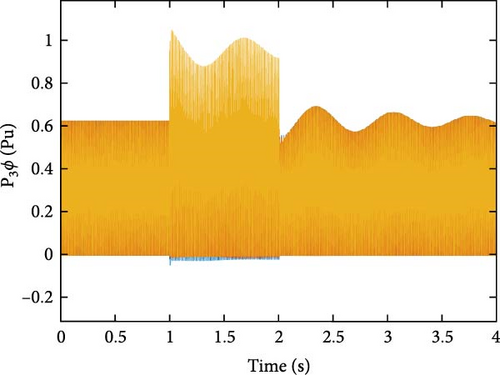

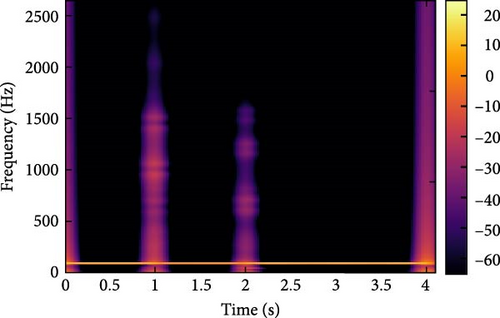
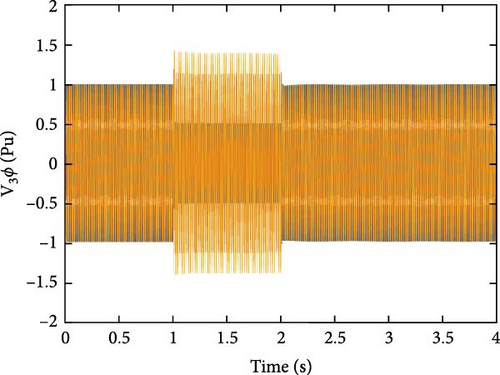
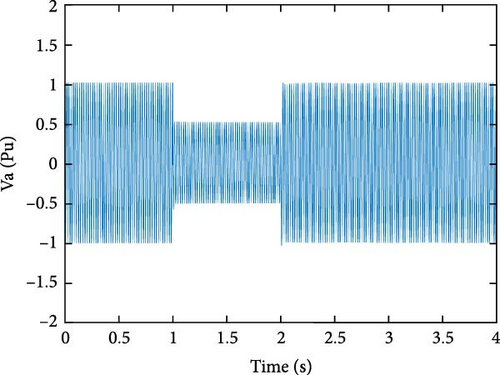
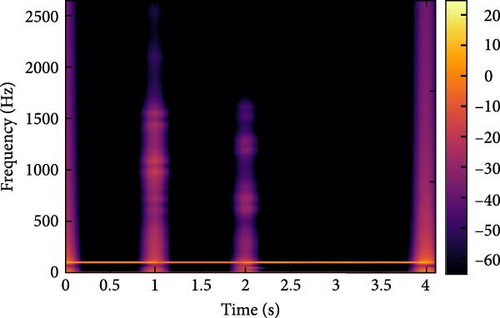
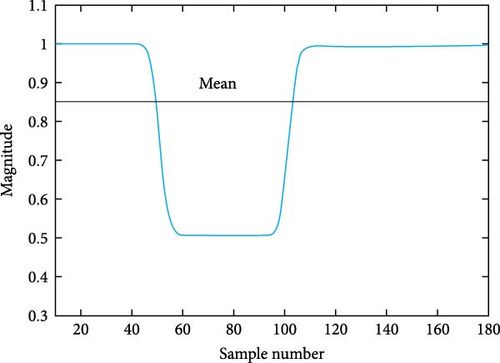
Through the implementation of diverse islanding and nonislanding events, a comprehensive spectrum of feature values can be acquired for each event category. In Figure 9, the input features and their associated values are presented, which are instrumental in event detection using the GT approach for the specific target DG. The feature values for islanding events (Figure 9a) exhibit distinct ranges, such as −41.7669 to −25.1491 for F1, 16.4839–25.2006 for F2, −41.7984 to −19.4178 for F3, 28.0043–28.4485 for F4, and 0.9999–1.0001 for F5. These ranges differ significantly from nonislanding occurrences, such as phase-to-phase fault events and capacitor bank switching events (depicted in Figure 9b,c). For example, the values of the features associated with capacitor bank switching events range from −43.5031 to −37.5772 for F1, 17.642–17.6945 for F2, −30.8625 to −29.208 for F3, 27.6016–28.3354 for F4, and 1.0014–1.0035 for F5. Similarly, the values of the features related to phase-to-phase fault events range from −8.8438 to −7.9587 for F1, 22.2778–23.359 for F2, −1.893 to −1.0344 for F3, 25.9814–26.7486 for F4, and 0.9652–0.9654 for F5. These distinct feature value combinations and ranges provide valuable insights for differentiating between islanding and nonislanding occurrences. By incorporating these distinctive case attributes, such as islanding and nonislanding events, the intelligent classification models can be effectively trained and utilized for accurate detection and classification.


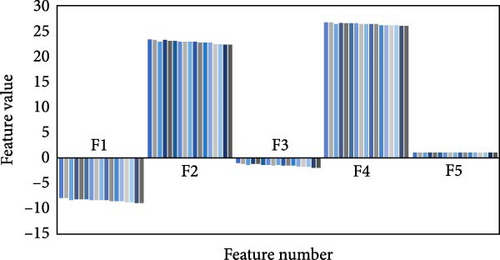
3.3. Performance Evaluation Methods
In order to effectively gauge the potency and precision of the proposed islanding detection technique, performance evaluation is crucial. This process enables the evaluation of a machine learning model’s performance on an unseen dataset, often referred to as the testing dataset. For the purpose of measuring the efficiency of the islanding detection and classification, a host of metrics have been utilized, including the following.
3.3.1. Accuracy
3.3.2. Precision
3.3.3. Recall
3.3.4. F1 Score
3.3.5. Log Loss
3.3.6. Area Under the Curve (AUC) (One Versus Rest)
Receiver operating characteristic–AUC (ROC-AUC) is a performance measurement for classification problem at various threshold settings. It tells how much the model is capable of distinguishing between classes. As described in Table 5, the higher the AUC, the better the model is at predicting 0 s as 0 s and 1 s as 1 s.
| AUC | Judgment of prediction |
|---|---|
| 1 | Demonstrate accurate distinguishing among all the points within the class |
| 0 | Identify all the incorrectly assigned class points |
| 0.5 < AUC < 1 | High chance of accurately distinguishing between class points |
- Abbreviation: AUC, area under the curve.
Understanding the significance of each of these metrics in different contexts helps in optimizing and adjusting machine learning models for specific needs. Feature importance is an invaluable instrument that aids in understanding the model and optimizing the data preprocessing phase to enhance the accuracy of the model. The significance of features can be derived and understood through these metrics.
4. Design of the Artificial Intelligence Classifiers
The implementation of DT-based classifiers such as the RF necessitates the inclusion of appropriate hyperparameter sets, as well as the division of data into training and testing portions during the preprocessing stage. This is crucial for optimal performance. The previous sections have elucidated the characteristics of the GT that can be employed as input for the classifier, covering a range of disturbance events. The requirement for the number of classifiers is contingent upon the quantity of DG units interfaced with the network. Consequently, the proposed approach exhibits the potential for implementation in expansive distribution networks housing numerous DG units, with each DG unit equipped with an individual intelligent classifier. The development of each classifier can adhere to the process delineated in Figure 10. All models’ algorithms have been utilized as an islanding detection classifier within a Jupyter Notebook environment. The classifiers have been designed using default setting parameters to ensure a fair comparison. Concurrently, identical training and testing data sets are employed to construct all classifiers. Table 6 presents a visual representation of the function names and initialization parameters that are utilized for the classifiers in the designated DG.
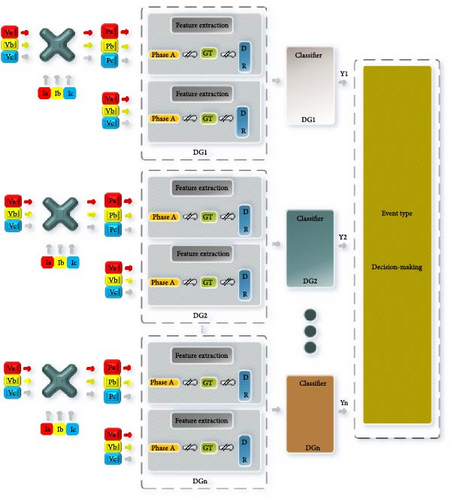
| Parameter setting | MLP1 | MLP2 | MLP3 | RandomForest | ExtraTrees | DecisionTree | CatBoost | XGBoost | LightGBM |
|---|---|---|---|---|---|---|---|---|---|
| Main package | sklearn.neural_network | sklearn.ensemble | sklearn.tree | CatBoost.CatBoostClassifier | xgboost.XGBClassifier | lightgbm.LGBMClassifier | |||
| Training data (training intrinsic) | 256 × 5 | ||||||||
| Validation data (training intrinsic) | 82 × 5 | ||||||||
| Testing data | 104 × 5 | ||||||||
| Iterations/estimators | max_iter = 300 | n_estimators = 50 | N/A |
|
n_estimators = 100 | ||||
| Accuracy metric | F1 score, accuracy, precision, recall, ROC-AUC, log loss | ||||||||
| Tree/layer arch | Hidden layers = (100, 50) | Hidden layers = (100, 100, 50) | Hidden layers = (100, 100, 100, 50) | Tree depth = none |
|
Tree depth = −1 | |||
| Supports missing values? | No | Yes | |||||||
| Supports categorical features? | No | Yes | No | Yes | |||||
| Needs feature scaling? | Yes | No | |||||||
| Model parallelism applied? | No | Yes | No | Yes | |||||
| Handle imbalanced dataset? | No | Yes | |||||||
- Abbreviations: AI, artificial intelligence; DG, distributed generation; ROC-AUC, receiver operating characteristic–area under the curve.
The proposed approach can be succinctly summarized in terms of its implementation phases, which are visually depicted in Figure 11:
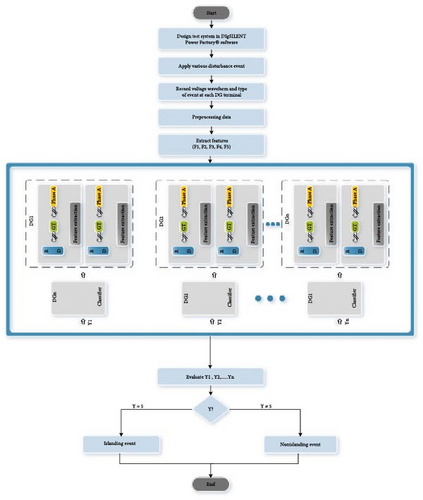
- Step 1:
Utilize the DIgSILENT Power Factory software to construct the testing system.
- Step 2:
Execute a diverse array of power quality scenarios, encompassing islanding events and nonislanding events, by utilizing the simulation model.
- Step 3:
Gather voltage and instantaneous power data for each phase signal at every DG terminal throughout the entirety of the simulated disturbance events. These events are distinctly categorized and identified by the predefined event class identifier as outlined in Table 2.
- Step 4:
Extract the selected features using the GT technique as described previously.
- Step 5:
Train the classifiers using the training data including the GT features. The present study employed nine distinct classifiers. The training component is executed through a process that occurs offline. These classifiers have the capacity to generate a collective of eight outputs. The specific quantity of classifiers utilized corresponds to the number of DG units integrated into the test system model.
- Step 6:
For any new input, utilize the trained network to identify and classify the type of event.
5. Studied System
The proposed methodology for detecting islanding is validated using a radial distribution system comprising two DG units that are identical, as presented in reference [35]. The system configuration is depicted in Figure 12. The power system is energized by a 120 kV, 1000 MVA source operating at a frequency of 50 Hz. The simulation of DG units is carried out through the utilization of synchronous machines, which are situated within a 30 km radius of a distribution π-sections line model. The system under investigation is described in Table 7. The system under examination has been replicated and emulated through the framework illustrated in Figure 12, utilizing DIgSILENT Power Factory software. The voltage and current signals are obtained at the specified DG site for both islanding and nonislanding events, as well as other disturbances. The simulations encompass the subsequent scenarios:
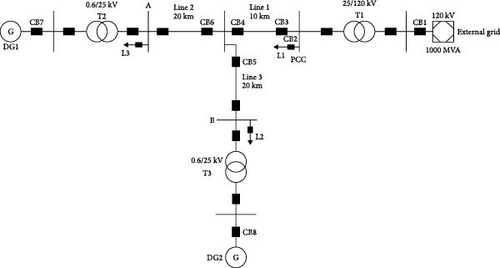
| Parameter | Description |
|---|---|
| External grid | 120 kV, 1000 MVA |
| L1 | 15 MW and 3 MVar |
| L2 and L3 | 8 MW and 3 MVar |
| DG1 and DG2 | 1200 Vdc |
| T1 | Transformer 120/25 kV |
| T2 and T3 | Transformer 25/0.6 kV |
| Line 1 | 25 kV with 10 km |
| Line 2 and Line 3 | 25 kV with 20 km |
| PCC | Point of common coupling |
| A and B | The point nearby the respective DG (A is a point near DG1; B is a point near DG2) |
- Abbreviations: DG, distributed generation; PCC, point of common coupling.
- 1.
Load and capacitor switching at different locations
- 2.
Different faults at various locations
- 3.
Loss of main supply at the PCC bus
- 4.
Islanding condition
- 5.
Tripping of other DGs apart from the target one
- 6.
Breaker and recloser tripping events
The DIgSILENT Power Factory software is utilized to model the associated circumstances across a range of operational configurations, encompassing typical DG loading, minimum DG loading, maximum DG loading, and the diverse DG operating points that result in NDZ. The radial distribution system with two identical DGs can be subjected to testing using three distinct NDZ conditions, as illustrated in Figure 13. The testing involves the manipulation of loading setpoints by both the consumers and the DGs.
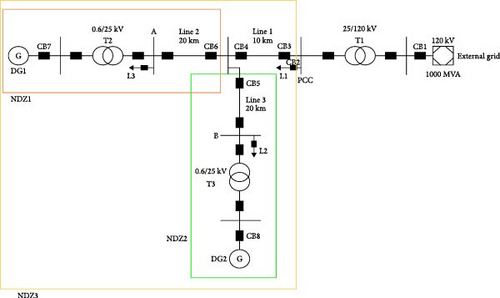
6. Results
Yout denotes the output of the classifier. As per the equation, an event will be classified as a nonlanding event if the classifiers corresponding to both DG1 and DG2 do not match the specified event class (target) number 5. If the classifier records a class number of 5 for an event, it is classified as an islanding event. The evaluative process of the classifiers was conducted through an analysis of error metrics and decision accuracy.
6.1. Result of GT With the Best MLP Classifier
The examination in this study was focused on the performance of a specific MLP classifier named MLP3, alongside GT features, for the detection and classification of islanding. The evaluation was carried out on multiple datasets following offline training. The tests included a wide range of disturbance scenarios, both islanding and nonislanding events, under typical conditions and within the NDZ. Compared to the other two versions of MLP, MLP1 and MLP2, MLP3 has a more complex architecture with larger hidden layers, providing it with potentially more expressive power. However, its training time was not significantly different, thanks to the efficiency of the underlying optimization algorithms. The precision of the MLP3 classifier was evaluated by juxtaposing the output of the MLP3 classifier with the actual target values. Based on the data represented in Table 8, MLP3 classifier can identify a 59.3% of the nonislanding events, while for the nonislanding events, the accuracy stands at a specific value about 25% with a training time of 1.4 s.
| Classes | Number of scenarios | Number of sample data | |
|---|---|---|---|
| Correct detection | Accuracy (%) | ||
| Nonislanding | 96 | 57 | 59.3 |
| Islanding | 8 | 2 | 25 |
6.2. Result of GT With the Best DT-Based Model Classifier
By employing analogous methodologies that incorporate GT characteristics in conjunction with an MLP classifier, the MLP is substituted with the best DT-based model, namely, ExtraTrees classifier and subsequently trained and evaluated using GT features. The testing outcomes encompass identical disturbance scenarios, comprising islanding and nonislanding incidents while operating under both normal and NDZ configurations. The set of five distinct features, denoted as F1, F2, F3, F4, and F5, is each assigned a corresponding variable x (0), x (1), x (2), x (3), and x (4), respectively. The ExtraTrees classifier’s training duration is 1.31 s. Subsequently, the ExtraTrees classifier’s output outcomes are juxtaposed with the projected or factual target values. As described in Table 9, the classifier exhibits a 100% detection rate for the islanding classes. In the case of nonislanding events, the precision level is 97.9%.
| Classes | Number of cases | Number of sample data | |
|---|---|---|---|
| Correct detection | Accuracy (%) | ||
| Nonislanding | 96 | 94 | 97.9 |
| Islanding | 8 | 8 | 100 |
6.3. Result of GT With the Best Gradient Boosting Model
In an effort to bolster the performance of the islanding detection algorithm when integrated with the existing classifiers, the MLP and RF classifiers have been substituted with a CatBoost model. This transition maintains the utilization of the same training and testing data. The proposed method encompasses two models. The first model was established with default configurations, while the second model underwent an optimization process, which entailed the selection of optimal hyperparameters, specifically tree depth, learning rate, and the number of iterations. The previous result was attained by employing the randomized search algorithm available in scikit-learn, wherein each trial was executed with four cross-validation folds. Table 10 provides an overview of the accuracy achieved by the GT feature selection technique in conjunction with the CatBoost classifier. It also offers a comparative assessment of the resulting output against the target data, allowing for performance evaluation. The classifier exhibits a 100% detection rate for the cases on the island. The precision rate for nonislanding occurrences is 98.9%. The optimal hyperparameter configurations of the fine-tuned model are illustrated in Figure 14. The comparison between the two models involved the use of the AUC metric. In Figure 15, we can observe the CatBoost model with its default configuration, depicted by the blue line, and the meticulously tuned model, illustrated by the red line. It is noteworthy that the optimized model reached an AUC value of 1, a perfect score, after approximately 65 iterations. This finding demonstrates the effectiveness of the optimization process. However, it is necessary to perform additional iterations for the default model to achieve an AUC of 1. The duration required for training is estimated to be around 0.88 s, which is comparatively lower than the training times of other classifiers. The analysis of feature importance in CatBoost reveals that, in the training process of the fine-tuned model, key features include F1, F2, and F5, which contribute significantly at 23.27%, 22.28%, and 23.24%, respectively. In contrast, F3 and F4 make fewer substantial contributions at 19.6% and 11.59%, respectively. Figure 16 depicts the root mean square error (RMSE) binary metric for 1000 iterations of the optimized model. In Figure 17, the confusion matrix reveals strong predictive accuracy for classes 3, 4, and 6, with notable misclassifications for classes 5 and 7. The majority zeroes in nondiagonal cells indicate clear class distinctions, although some confusion between classes 5, 4, and 6 is evident. This suggests the model’s effectiveness with certain classes while highlighting potential areas for improvement.
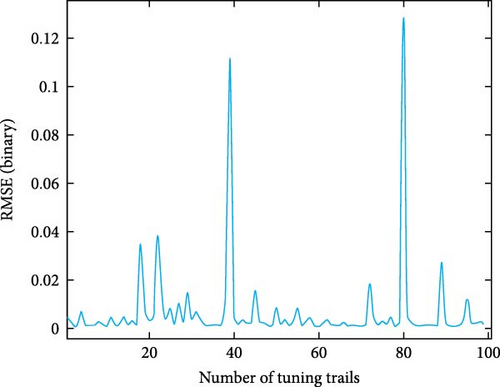
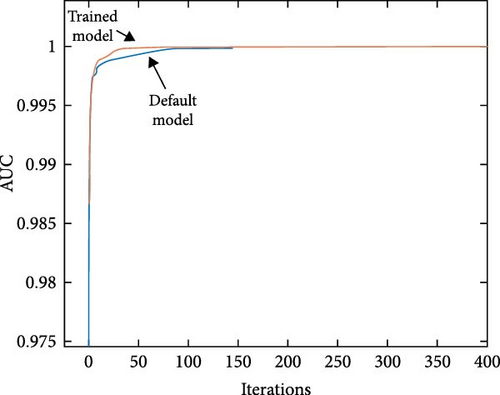
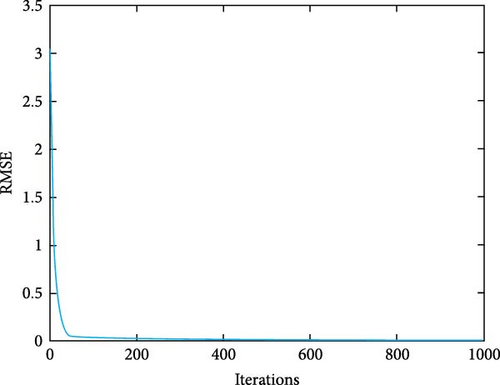
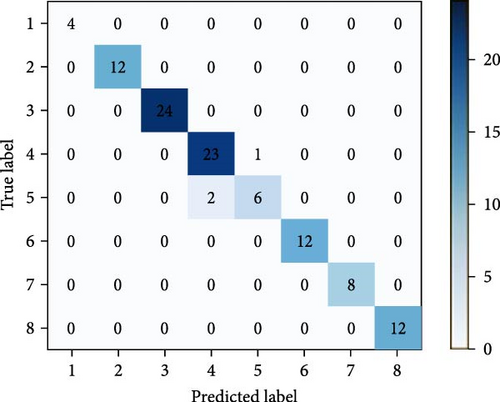
| Classes | Number of scenarios | Sample data number | |
|---|---|---|---|
| Correct detection | Accuracy (%) | ||
| Nonislanding | 96 | 95 | 98.9 |
| Islanding | 8 | 8 | 100 |
The results of the model evaluation are presented in Table 11. The table provides an overview of the performance metrics, including precision, accuracy, ROC-AUC, F1 score, log loss, and recall as shown in Figures 18–23, respectively, for each of the evaluated models. Among the models, CatBoost, ExtraTrees, and MLP3 achieved the highest accuracy scores, all exceeding 97%. These models demonstrated a strong ability to classify instances correctly. Similarly, they exhibited high precision, recall, and F1 score values, indicating their effectiveness in both positive and negative class predictions. In terms of the ROC-AUC metric, all models achieved impressive results, with values ranging from 0.998 to 1.000. This suggests that the models can effectively discriminate between different classes and have high predictive power. Notably, CatBoost achieved a perfect ROC-AUC score of 1.000, indicating its exceptional discriminative ability. The log loss metric measures the model’s calibration and uncertainty estimation. Lower log loss values indicate better model performance. In this regard, MLP3 achieved the lowest log loss among all models, followed by MLP2 and ExtraTrees. These models demonstrated superior calibration and accurate probability estimates. It is worth noting that DT and MLP1 obtained slightly lower scores in terms of accuracy, precision, recall, F1 score, and ROC-AUC compared to the other models. However, they still exhibited reasonably good performance, indicating their potential usefulness in certain scenarios. Overall, the evaluation results demonstrate that the models, particularly CatBoost, ExtraTrees, and MLP3, are highly capable of accurately detecting and classifying islanding events.
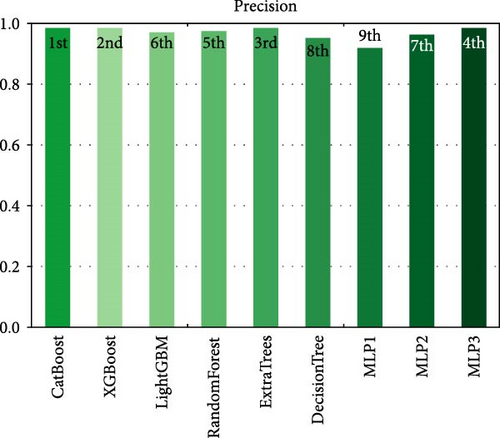
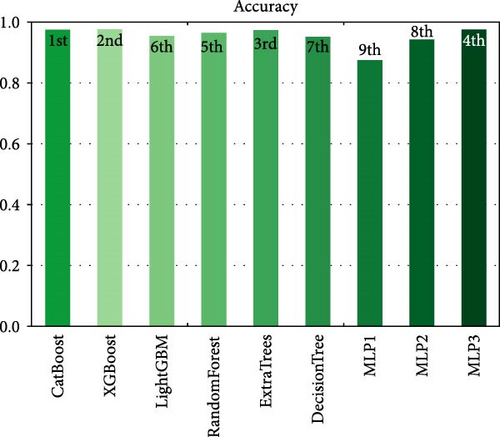
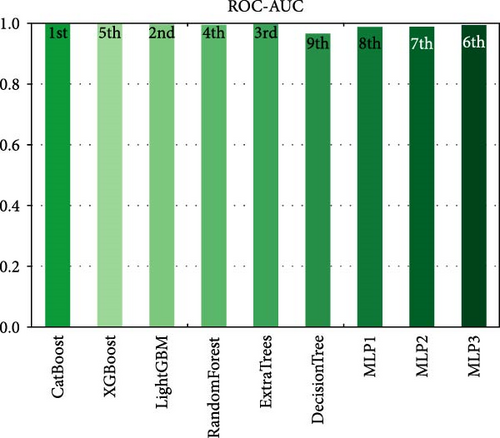

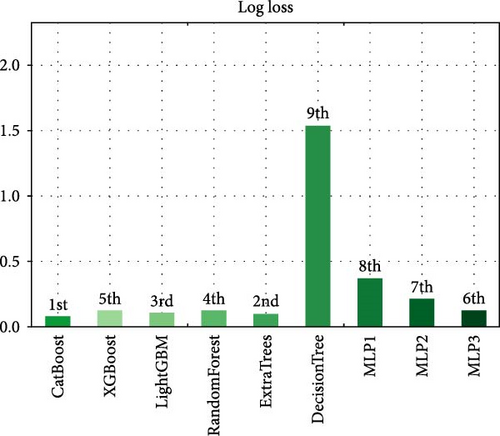

| Model | Accuracy | Precision | Recall | F1 score | ROC-AUC | Log loss |
|---|---|---|---|---|---|---|
| CatBoost | 0.977528 | 0.986111 | 0.964286 | 0.971814 | 1 | 0.09272 |
| XGBoost | 0.977528 | 0.986111 | 0.964286 | 0.971814 | 0.998048 | 0.129105 |
| LightGBM | 0.955056 | 0.975 | 0.945055 | 0.954861 | 0.999136 | 0.115104 |
| RandomForest | 0.966292 | 0.977183 | 0.951786 | 0.960605 | 0.998369 | 0.121602 |
| ExtraTrees | 0.977528 | 0.986111 | 0.964286 | 0.971814 | 0.999129 | 0.107108 |
| DecisionTree | 0.955056 | 0.955532 | 0.943973 | 0.948582 | 0.96869 | 1.552305 |
| MLP1 | 0.876404 | 0.921528 | 0.876717 | 0.88849 | 0.990203 | 0.374481 |
| MLP2 | 0.94382 | 0.964461 | 0.930804 | 0.93984 | 0.991334 | 0.217469 |
| MLP3 | 0.977528 | 0.986111 | 0.964286 | 0.971814 | 0.996206 | 0.135801 |
- Abbreviation: ROC-AUC, receiver operating characteristic–area under the curve.
7. Conclusion
The present study introduced a novel algorithm that utilizes the GT method or feature extraction from both phase-specific instantaneous power and voltage waveforms. The primary objective of this approach is the precise classification of islanding and nonislanding events occurring at a designated DG site. The proposed methodology is assessed by employing multiple disturbance signals, including islanding operational states and different nonislanding network states, such as fluctuations in DG power, faults, load switching, capacitor switching, and NDZ conditions. The outcomes of the conducted tests conclusively demonstrate that the algorithm designed for islanding detection excels in its capacity to precisely identify and detect instances of islanding. To validate the effectiveness of the method, a comprehensive comparison is conducted, pitting it against a conventional approach involving eight distinct classifiers. The comparison reveals that the proposed detection method, featuring the combination of CatBoost and GT features, achieves an impressive accuracy rate of 98.9% in the detection of islanding regions. In contrast, the approach involving ExtraTrees and GT features attains a commendable accuracy of 97.7%. However, MLP3 in conjunction with GT features reaches a lower accuracy rate of 59.3%. Furthermore, the results unequivocally underscore the superior performance of the CatBoost classifier over the other classifiers employed in the evaluation. Moreover, the performance was evaluated using some metrics, and the GT with CatBoost classifiers was found to be more accurate than the GT technique with other classifiers. The CatBoost model is further improved by performing a hyperparameters tuning with more accurate results captured. The proposed methodology can be used for detection of islanding in which it can avoid and prevent dangerous situations and protect the stability of the system and the connected grid after restoration.
Conflicts of Interest
The authors declare no conflicts of interest.
Funding
This research was not funded by any organization or university.
Acknowledgments
The authors express their sincere gratitude for the support provided by the Department of Electrical and Communication Engineering, United Arab Emirates University, Al Ain, United Arab Emirates.
Open Research
Data Availability Statement
The data presented in this study are available on request from the corresponding author.




